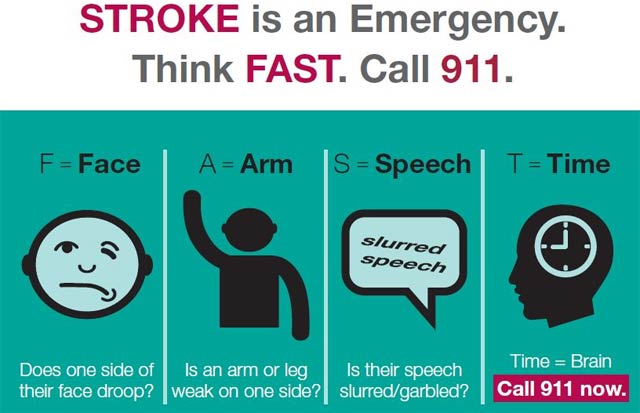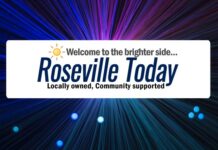Every 40 seconds someone in the U.S. has a stroke, according to the U.S. Center for Disease Control and Prevention.
While strokes may be the fifth leading cause of death, they are the leading cause of permanent disability in the U.S. The earlier a stroke is recognized and treated, the greater the chance of recovery. Knowing the signs and symptoms of a stroke is the first step to ensuring medical help is received immediately.
Warning Signs of a Stroke
A stroke occurs when a blood vessel that feeds the brain is blocked or bursts. Strokes can happen to anyone at any time, but people with diabetes, heart disease, high blood pressure, high blood cholesterol and those over the age of 55 are at a greater risk. To protect yourself and your loved ones, learn the warning signs of stroke and remember to act quickly.
Fast treatment is key to saving lives and preventing disabilities. 80 percent of strokes can be prevented, according to the National Stroke Association.
“There are ways to lower your risk of a stroke by making simple lifestyle adjustments, and the ability to recognize a stroke when it happens can save lives,” said Kris McNeill, R.N., stroke coordinator at Sutter Auburn Faith Hospital.
According to McNeill, these are the other warning signs you should look out for:
* Sudden trouble walking, dizziness, loss of balance or coordination.
* Sudden weakness in the face, arm or leg and sudden confusion.
* Sudden severe headache with no known cause.
* Neck stiffness, seizures, irritability and unconsciousness.
Symptoms most often develop suddenly, but some types of strokes may cause symptoms to develop progressively over a period as long as a few days. Sometimes symptoms can disappear on their own. McNeill recommends that if you notice changes – either sudden or gradual – that appear in the list of symptoms, get immediate medical attention.
“Depending on the type of stroke, treatments are time sensitive so it’s important to seek medical care immediately. People who receive emergency medical treatment within the first few hours hours of their first stroke symptoms tend to have less disability later than those who delayed care,” warns McNeill.
Prevention
To help you reduce your risk of a stroke, McNeill suggests you exercise, eat a healthy diet that is low in sodium, maintain a healthy weight, drink alcohol in moderation and stop smoking.
“High blood pressure is one of the leading causes of strokes,” she said. “Adults 55 and older and those with a family history of strokes are most at risk. It’s important to listen to your body and trust your instincts if you think you are experiencing stroke symptoms, get professional help right away.”
Using technology to advance local care
Sutter Auburn Faith Hospital is a certified Primary Stroke Center by the Joint Commission providing around-the-clock emergency diagnosis and treatment to stroke patients. Medical specialists, nurses and support staff are dedicated to reducing the incidence and impact of strokes.
The hospital’s Telestroke program, now in its second year, provides quick and comprehensive treatment for patients demonstrating stroke symptoms. Telestroke allows direct one-on-one video consultation with stroke neurologists at California Pacific Medical Center, to determine the best treatment options for patients, a practice that is supported by the 2018 American Stroke Association guidelines.
“When a patient has a stroke, time is essential. Our Telestroke program allows us to bring specialty care to our patients as soon as they reach the Emergency Department,” says McNeill.
A supportive environment – Community Support Group
Strokes impact not only the patient, but also the patients’ family members as they begin to recover. Having a network of community members that have experienced a stroke can be helpful. Sutter Auburn Faith Hospital hosts a stroke support group every third Thursday of the month from 10:30 a.m. – noon to engage in discussions with members of the community and clinical staff. Please call 530-889-6088 for more information.
“Providing stroke patients with the best care possible is our first and foremost goal” said McNeill. “That also means offering support and rehabilitation services to those that have a stroke and offering social connections and assistance as they recover.”
For more information about strokes, visit https://sutterauburnfaith.org or stroke.org.
(21+ years strong)
Welcome to the brighter side!
Get in front of local customers! 24/7 (365)





















